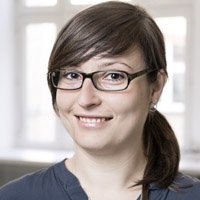
Rebekka Lauer
After training as a goldsmith at the Staatliche Zeichenakademie Hanau (Hanau Academy of Art) and completing an apprenticeship, Rebekka Lauer studied at the Weißensee Academy of Art Berlin. She gained her diploma in Product Design with a major in Interaction Design in 2012. For her diploma project, she designed »Phyo – Computer-Aided Physiotherapy«, a therapeutic application designed to support patients and therapists. The accompanying theoretical part of the project examined interpersonal interactions, comparing these to 3D gesture control by machines.
Her research interests are centred on the mediation between abstract, digital spheres and physically experienceable, analogue work, and she explores questions relating to (interdisciplinary) collaboration. A key aspect of her research is the process of exchanges and mediation between disciplines and people, and the organisation of complex data in the digital sphere and the question of access to this data.
During her work on the project »Indexing of Collections«, she designed »Culture Collaboratory. Virtual Workspace for Collections Research and Management«. It is situated in the tension between skilled manual activities and scientific knowledge production in the analogue sphere on the one hand and the processes that this entails in the digital sphere on the other. It combines aspects of sustainable research documentation, innovative data visualisations of artworks and cultural assets, and a radically context- and object-centred information repository (annotations) to create a research platform. It transforms the purely archival repository systems found in conventional (museum) databases into an interactive knowledge workspace for all the disciplines involved.
In the project »Image Guidance«, she has returned to the field of medical and therapeutic applications, an area that she previously explored during her studies. This time the setting is clinical routines in neurosurgery and their medical images. Here, too, her work centres on the possibilities for interacting with medical images as the interface between the analogue and the digital, communicating with and about this process, and the use of the images in the setting. Daily routines in the hospital, the knowledge doctors require on the images, software and hardware, and the possible strategies for communicating this to the next generation of doctors are some of the keywords in this field of work.

